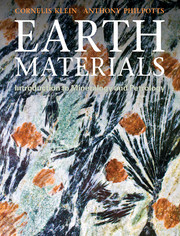Book contents
- Frontmatter
- Contents
- Preface
- Acknowledgments
- Chapter 1 Introduction
- Chapter 2 Materials of the solid Earth
- Chapter 3 How are minerals identified?
- Chapter 4 Fundamentals of crystal structures
- Chapter 5 Introduction to crystallography
- Chapter 6 Minerals and rocks observed under the polarizing optical microscope
- Chapter 7 Igneous rock-forming minerals
- Chapter 8 How do igneous rocks form?
- Chapter 9 Igneous rocks
- Chapter 10 Sedimentary rock-forming minerals and materials
- Chapter 11 Formation, transport, and lithification of sediment
- Chapter 12 Sedimentary rock classification, occurrence, and plate tectonic significance
- Chapter 13 Metamorphic rock-forming minerals
- Chapter 14 Metamorphic rocks
- Chapter 15 Some economic minerals, mainly from veins and pegmatites
- Chapter 16 Some selected Earth materials resources
- Chapter 17 Earth materials and human health
- Glossary
- Minerals and varieties
- Common igneous, sedimentary, and metamorphic rocks
- Index
Chapter 13 - Metamorphic rock-forming minerals
- Frontmatter
- Contents
- Preface
- Acknowledgments
- Chapter 1 Introduction
- Chapter 2 Materials of the solid Earth
- Chapter 3 How are minerals identified?
- Chapter 4 Fundamentals of crystal structures
- Chapter 5 Introduction to crystallography
- Chapter 6 Minerals and rocks observed under the polarizing optical microscope
- Chapter 7 Igneous rock-forming minerals
- Chapter 8 How do igneous rocks form?
- Chapter 9 Igneous rocks
- Chapter 10 Sedimentary rock-forming minerals and materials
- Chapter 11 Formation, transport, and lithification of sediment
- Chapter 12 Sedimentary rock classification, occurrence, and plate tectonic significance
- Chapter 13 Metamorphic rock-forming minerals
- Chapter 14 Metamorphic rocks
- Chapter 15 Some economic minerals, mainly from veins and pegmatites
- Chapter 16 Some selected Earth materials resources
- Chapter 17 Earth materials and human health
- Glossary
- Minerals and varieties
- Common igneous, sedimentary, and metamorphic rocks
- Index
Summary
This chapter presents the systematic mineral descriptions of 26 of the most common metamorphic minerals. All of these are silicates except for one, corundum, an oxide. Such minerals are the result of chemical reactions involving preexisting minerals in sedimentary, igneous, or metamorphic rocks. These reactions may result from changes in temperature, pressure, fluids, and shearing stress at considerable depth in the Earth (see Chapter 14). Mineral reactions that are the result of an increase in temperature are referred to as prograde, whereas those that result from falling temperatures are retrograde. Retrograde metamorphic reactions commonly involve the addition of fluids.
Systematic mineralogical descriptions of common metamorphic minerals
The order in which metamorphic minerals are discussed in this chapter reflects their relative abundance. We begin with minerals that are common in some of the most abundant metamorphic rock types. An example of such an abundant rock type would be what is known as a pelitic schist. A pelitic schist is a rock derived by metamorphism of an argillaceous (meaning composed of clay-sized particles or clay minerals) or fi ne-grained aluminous sediment. Prograde metamorphic reactions in such a rock may produce sequentially metamorphic assemblages rich in chlorite and muscovite; subsequently garnet-staurolite-biotite-muscovite assemblages; and at the highest temperature, sillimanite-garnet-cordierite-feldspar assemblages. Members of the mica group (muscovite and biotite) and the feldspars are major constituents of these metamorphic rocks but their systematic descriptions are given in Chapter 7 because they are also major constituents of igneous rocks. Similarly quartz, abundant in igneous, sedimentary, and metamorphic rocks, was discussed in detail in Chapter 7. This means that because the systematic mineralogy in this text is arranged by common occurrence in igneous, sedimentary, and metamorphic rock types, those minerals that are common to two or all three of these lithologic divisions are described only once. Therefore, although micas, quartz, and feldspar may be common constituents in metamorphic rocks, you must refer to these minerals in Chapter 7, where they were first described. Here we concentrate on those minerals that are newly formed as a result of metamorphic reactions.
- Type
- Chapter
- Information
- Earth MaterialsIntroduction to Mineralogy and Petrology, pp. 366 - 389Publisher: Cambridge University PressPrint publication year: 2012



